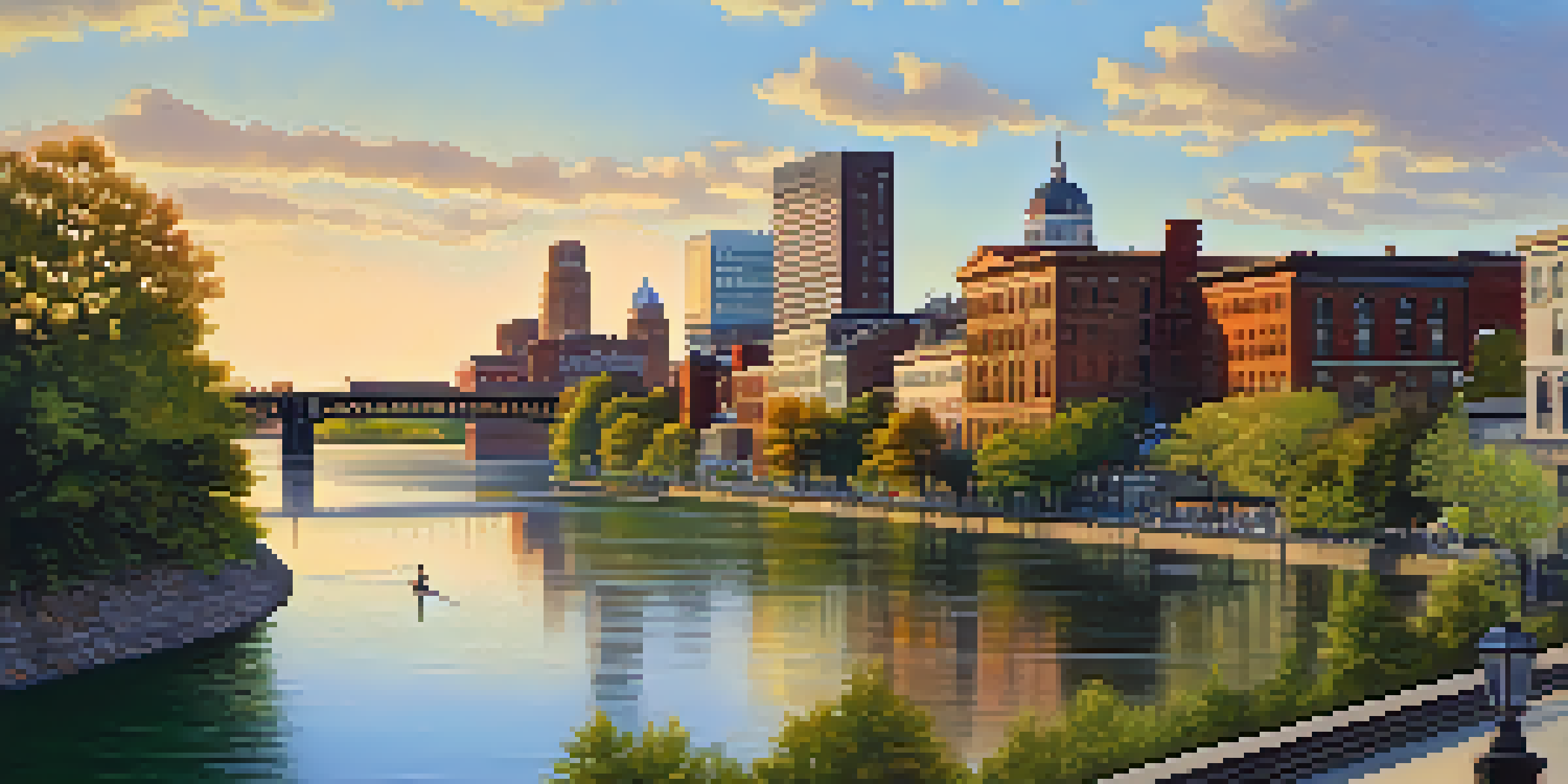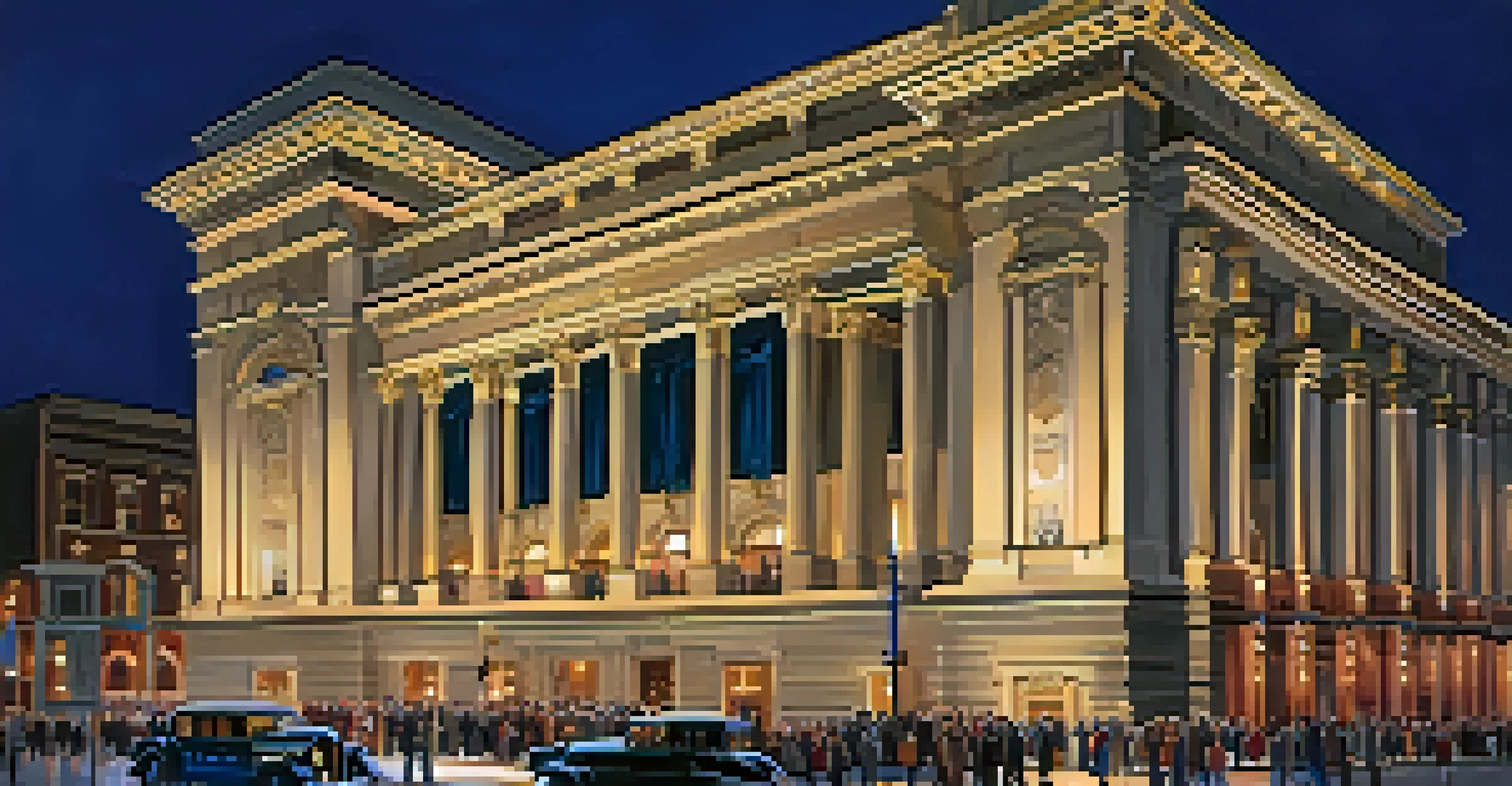Rochester's Historical Landmarks: Stories of the Past

The Origins of Rochester: A Journey Through Time
Rochester, New York, has a vibrant history that dates back to the early 19th century. Established in 1817, it quickly became a hub for industry and commerce, thanks to its strategic location near the Genesee River. The city played a pivotal role during the Industrial Revolution, which led to its rapid growth and development.
History is not a burden on the memory but an illumination of the soul.
Many of Rochester's foundational stories are tied to its landmarks, such as the Genesee Brewing Company, which symbolizes the city's brewing heritage. From the bustling markets to the factories, each site tells a story of innovation and resilience. These historical elements are not just remnants of the past; they contribute to the city's identity today.
As you walk through Rochester, you can almost hear the echoes of the past, where industry met community. Each corner reveals stories of the people who built this city, making it a living museum filled with history waiting to be uncovered.
The Iconic Eastman Theatre: A Cultural Gem
Opened in 1922, the Eastman Theatre stands as a testament to Rochester's dedication to the arts. Designed by the renowned architect Harold Van Doren, this venue has hosted countless performances, from symphonies to contemporary concerts. Its opulent architecture and exceptional acoustics make it a beloved spot for both performers and audiences alike.

The theatre was a gift from George Eastman, the founder of Eastman Kodak Company, who envisioned a space for cultural enrichment. This landmark not only showcases the artistic spirit of Rochester but also highlights the community's commitment to supporting the arts. It's a place where memories are made, and talent is nurtured.
Rochester's Rich Historical Legacy
Rochester's history is deeply intertwined with its landmarks, each telling stories of innovation and resilience.
Visiting the Eastman Theatre is like stepping into a different era, where the grandeur of the past meets the vibrancy of present-day performances. It serves as a cultural hub, reminding us of the importance of art in our lives and its power to connect people from all walks of life.
The Historic Highland Park: Nature Meets Heritage
Highland Park, established in 1888, is not just a beautiful green space but also a historical landmark rich with stories. Designed by landscape architect Frederick Law Olmsted, it features stunning gardens, walking paths, and the famous Lilac Festival, drawing visitors from near and far. The park's diverse plant collections and peaceful ambiance offer a respite from city life.
The past is never dead. It's not even past.
Throughout its history, Highland Park has served as a gathering place for community events and celebrations. The park's design reflects a commitment to creating spaces that enhance quality of life, making it a cherished part of Rochester's heritage. It's a place where families have picnicked, friends have gathered, and memories have been made.
Exploring Highland Park allows you to appreciate the natural beauty intertwined with the city's history. Each season brings a different charm, from the vibrant lilacs in spring to the colorful foliage in fall, reminding us that nature, too, has its stories to tell.
The Strong National Museum of Play: A Celebration of Fun
The Strong National Museum of Play is a unique landmark that celebrates the importance of play in human culture. Opened in 1968, this museum is dedicated to the history and exploration of play, showcasing everything from vintage toys to interactive exhibits. It serves as a reminder that play is not just for children; it's a vital part of life for everyone.
Visitors can immerse themselves in the world of play through hands-on experiences that spark creativity and imagination. The museum also houses the National Toy Hall of Fame, honoring toys that have made a significant impact on childhood. This fusion of history and fun creates a captivating environment for visitors of all ages.
Cultural Significance of Arts
The Eastman Theatre exemplifies Rochester's commitment to the arts, serving as a cultural hub that nurtures talent and creativity.
The Strong National Museum of Play highlights Rochester's role as a center for innovation in toy design and childhood education. It's a place where the past and present collide, reminding us that the joy of play is timeless and essential for personal growth and connection.
The Landmark Society of Western New York: Preserving History
The Landmark Society of Western New York plays a crucial role in preserving Rochester's architectural heritage. Founded in 1937, this organization is dedicated to advocating for historic preservation and promoting the significance of the region's landmarks. Their efforts ensure that the stories of Rochester's past are not forgotten.
Through various initiatives, the Landmark Society helps restore and maintain historical buildings, ensuring they remain a part of the community. They offer educational programs and tours that highlight the architectural diversity of the area, fostering appreciation for the city's history. This commitment to preservation enriches the cultural landscape of Rochester.
By supporting the work of the Landmark Society, residents and visitors alike can contribute to the ongoing narrative of Rochester's history. Each preserved building carries with it a story, offering a glimpse into the lives of those who came before us and shaping our understanding of the present.
The Genesee River: A Historical Waterway
The Genesee River is more than just a natural feature; it's a vital part of Rochester's history. This river has served as a transportation route for Native Americans and early settlers alike, facilitating trade and exploration. Its banks have witnessed significant events that shaped the development of the city.
Throughout the years, the river has been integral to Rochester's industrial growth, powering mills and factories that contributed to the economy. Today, it remains a focal point for recreation and community events, connecting people to the city's heritage. The Genesee River provides a picturesque backdrop for parks, trails, and festivals.
Importance of Preservation Efforts
Organizations like the Landmark Society play a crucial role in preserving Rochester's architectural heritage and educating the community about its history.
Exploring the shores of the Genesee River allows us to appreciate its historical significance and the role it continues to play in the community. It's a reminder of the interplay between nature and urban development, illustrating how both can coexist harmoniously.
The Susan B. Anthony House: A Beacon of Women’s Rights
The Susan B. Anthony House is a landmark that symbolizes the fight for women's rights in America. This historic home was the residence of the famous suffragist from 1866 until her death in 1906. It served as a hub for activism, where Anthony and her colleagues strategized for the women's suffrage movement, advocating for equality and justice.
Today, the house is a museum that educates visitors about Susan B. Anthony's life and the larger context of the suffrage movement. Exhibits showcase her work and the struggles faced by women in their quest for the right to vote. This landmark stands as a testament to the power of determination and the importance of civic engagement.

Visiting the Susan B. Anthony House offers an opportunity to reflect on the progress made in women's rights and the work that still lies ahead. It inspires visitors to honor the legacy of those who fought for equality and to continue the journey toward justice for all.
Rochester's Historic Sites: A Tapestry of Stories
Rochester is a city rich with historical landmarks, each contributing to the tapestry of its unique narrative. From the impressive architecture of the George Eastman Museum to the charm of the Seneca Park Zoo, these sites offer a glimpse into the past while engaging the community today. Each location tells a story that connects generations.
Exploring these landmarks allows residents and visitors to appreciate the diverse experiences that have shaped Rochester. They serve as reminders of the city's resilience, creativity, and commitment to progress. Whether it’s an art gallery or a historical home, each site invites exploration and reflection.
As we uncover the stories behind these landmarks, we deepen our understanding of Rochester's heritage. These sites not only enrich our lives but also inspire us to preserve the past for future generations, ensuring that the vibrant history of Rochester continues to thrive.